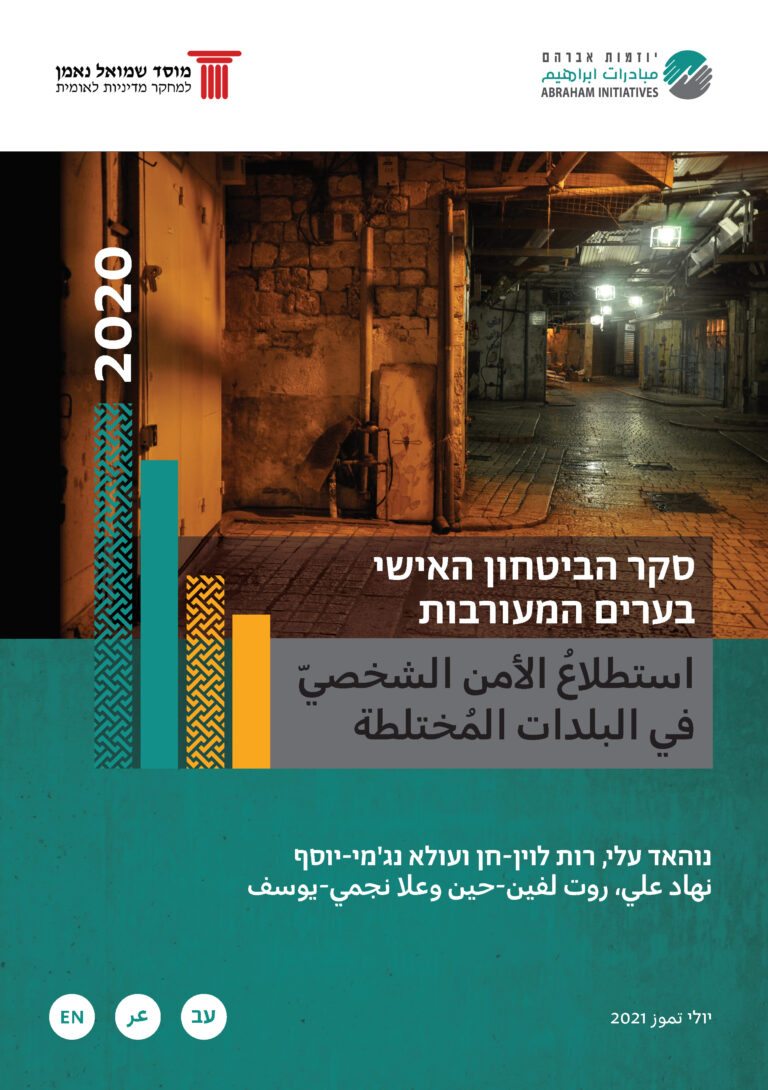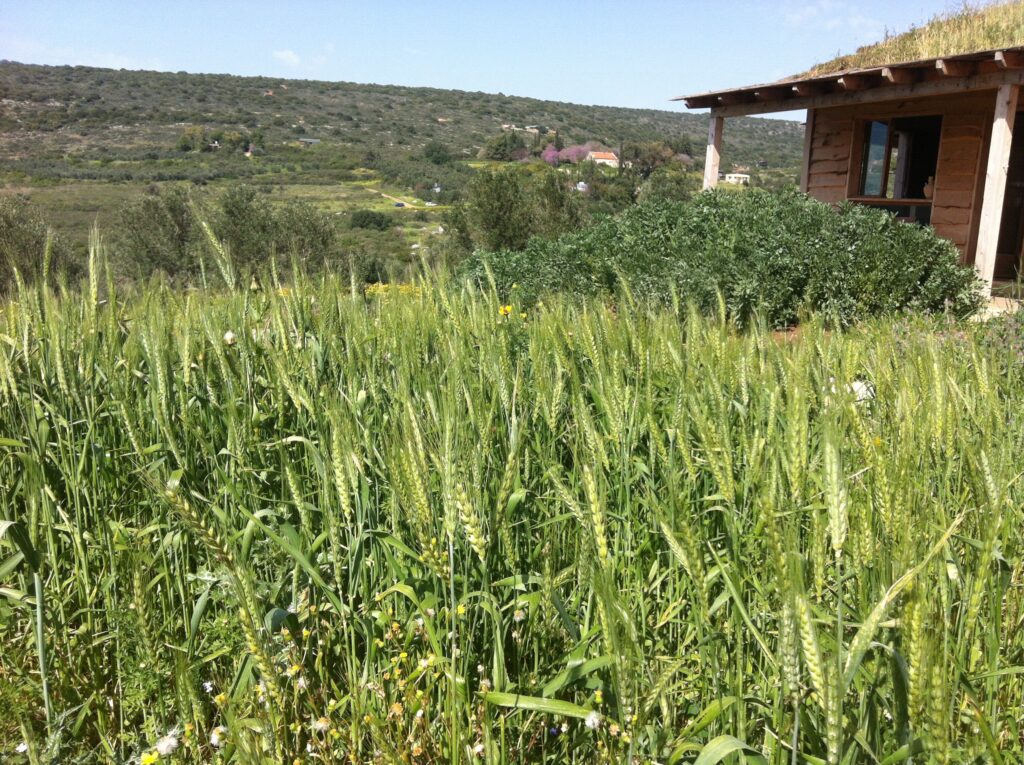The Survey of Personal Security in Arab Society in the Mixed Cities for 2020 is the first report focusing on issues of violence, crime, and policing in this population.
This publication complements the reports of the Personal and Communal Security Index published annually by the Abraham Initiatives and the Samuel Neaman Institute for National Policy Research at the Technion.
These reports offer a description of attitudes among Arab citizens on the issues of policing and violence.
This report was prepared due to the recognition that while Arab society as a whole has suffered from a difficult reality of rising violence and crime over recent years, the Arab residents of the mixed cities are disproportionately represented in violent incidents by comparison to Arab society as a whole. This issue has not received sufficient attention on the public agenda.
Firstly, it is important to understand the meaning of a “mixed city” as the focus of this report.
The concept of “mixed cities” in Israel refers to cities where Jews and Arabs live in juxtaposition.
However, there are different types of mixed cities. Some of the mixed cities in Israel are historical mixed cities, where Jews and Arabs lived together prior to 1948; these cities had substantial Arab majorities prior to the establishment of Israel. Examples of such cities include Ramle, Lod, and Akko, as well as Tel Aviv — Jaffa, which was created in 1949 by the merger of Jewish Tel Aviv and Arab Jaffa.
Other mixed cities were established as Jewish cities, but over the years received Arab residents seeking to improve their standard of living. These cities include Nof Hagalil (formerly Nazareth Illit), as well as emerging mixed cities such as Carmiel, Afula, and Tzfat. Ma’alot-Tarshiha was created through the merger of the longstanding Arab village of Tarshiha and the newer Jewish town Ma’alot.
One statistic that highlights the need to discuss the phenomenon of violence and crime in Arab society in the mixed cities concerns the victims of manslaughter and murder in the population in recent years. In 2018, 19 Arab residents of mixed cities were killed in violent circumstances, out of a total of 71 Arab citizens killed in that year (27 percent of the total).. In 2019, the figure rose to 21 (24 percent of the 89 Arab citizens killed in that year.). In 2020, the number of Arab residents of mixed cities killed was again 21 (22 percent of the total of 96 Arab fatalities for that year). These figures are striking given that Arab residents of mixed cities account for only 10 percent of the total Arab population.
In order to gain a better understanding of the attitudes of Jewish and Arab residents of the mixed cities concerning the phenomena of crime and violence, we conducted a survey in which residents were asked about their feelings relating to different aspects of crime and relating to the work of the police and other official and civil society institutions to curtail these phenomena.
As we have noted in previous publications,3 the phenomenon of violence in Arab society was not created in a vacuum. There are many reasons for this phenomenon, including:
the socioeconomic condition of the Arab population — half of all Arab families are defined as poor, and almost two-thirds of Arab children live under the poverty line; extensive unemployment — particularly among young people; changes in the functioning of the family in Arab society and a transition to a more individualistic way of life, so that the family does not serve as a source of security and law enforcement, as it did in the past — while at the same time the authorities do not fill this function adequately in the lives of Arab citizens; a shortage of land and housing in Arab society, particularly in the mixed cities, which have failed to offer appropriate housing solutions for their growing Arab populations; and poor relations with the Israel Police, which over the years has seen Arab citizens as a potential security threat and denied them proper policing services. The work of the police, which shows signs of both over-policing and under¬policing,4 is also apparent in the mixed cities. Unlike the Arab locales, police stations are not a new presence in the mixed cities, but the attitude of police officers to the Arab residents of the mixed cities is not the same as their attitude toward Jewish residents, and relations between the police and residents are dominated by tension and friction.
In addition to the ongoing increase in violence, 2020 also saw the outbreak of the COVID-19 pandemic in Israel and around the world. The virus, which began to spread in Israel in March 2020, created a new and tangible threat to Israeli society as whole, and Arab society in particularly. The new state of emergency that ensued caught Arab society underprepared, due to the prevailing perception of Arab society as a separate entity that is not threatened by states of emergency, at best, or is itself part of the circle of enemies responsible for such situations, at worst. As a result, Arab society entered the COVID-19 crisis less prepared than other parts of Israeli society to cope with a state of emergency.
Moreover, certain features of Arab society left it particularly vulnerable to the pandemic by comparison to other groups in Israeli society. The COVID-19 regulations constitutes a serious challenge to social norms in Arab society, which play a central role that should not be dismissed.
The rules required Arab citizens to limit their communal and family activities, which serve as pillars of everyday life, and to replace these with social distancing and the avoidance of religious and communal practices. Physical proximity to members of the extended family who live nearby encourages encounters and contact, while the nature of the epidemic resulted in a need to halt such encounters entirely. In economic terms, the COVID-19 crisis caused particularly serious damage to those in part-time and blue collar employment, who are overrepresented in Arab society.
Due to the need to enforce the COVID-19 regulations, there was an increased presence of police and military personnel throughout Israel, including the Home Front Command. The frequent encounters between the security forces and Arab citizens offered an opportunity to improve trust in the police, as part of the common civil struggle against an epidemic that does not distinguish between Jews and Arabs. However, these encounters also included violent friction against the background of the enforcement of the regulations.
- The Survey of Personal and Community Security in the Mixed Cities for 2020 focused on four issues:
- The feelings and attitudes of the residents of the mixed cities regarding the scope of violence and crime in their communities, and regarding specific phenomena of violence;
- the level of exposure of citizens to violence and crime, whether directly or among their friends and relatives;
- the willingness of Arab citizens to help in the struggle against violence; and
- attitudes among Arab citizens toward the police and their impressions concerning police behavior toward them.
In light of the central importance of issues relating to the COVID-19 pandemic in the lives of Jewish and Arab citizens in 2020, we also decided to include questions in the survey examining the level of concern among residents at the spread of the virus and their satisfaction with the functioning of various institutions in combating the pandemic.
The survey was conducted among a representative sample of Arab society in the mixed cities of Ma’alot-Tarshiha, Akko, Haifa, Lod, Ramle, and Tel Aviv — Jaffa.
For comparison purposes, a survey was conducted among a representative sample of Jewish society in these cities. Since a survey including identical questions was also conducted in Arab and Jewish society on the national level, as part of the Personal and Community Security Index, some of the questions in this report included a comparison between the populations in the mixed cities and the populations (Jewish and Arab) on the national level.
The survey paints a depressing picture of the phenomena of crime and violence and their impact on the lives of the residents of the mixed cities. Moreover, the findings show that these phenomena do not only affect Arab residents, but also have a ripple effect among Jewish society in these cities, who experience a greater threat of violence than other Jewish citizens.












